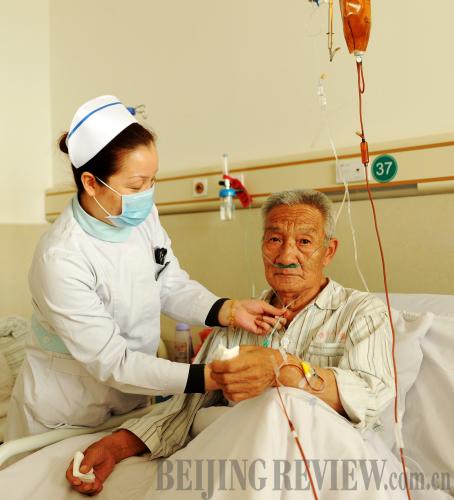|
 |
|
BROADER COVERAGE: Lung, esophagus and gastric cancers are all covered by a social insurance program for those suffering from serious diseases as of 2013 (XINHUA) |
Ma added that a research conducted by the American Cancer Society between 1982 and 1998 found a correlation between levels of particulate matter that is 2.5 micrometers or smaller in size (PM2.5) and lung cancer mortality rates. The research team observed increases of 8 percent in deaths from lung cancer with PM2.5 increases of 10 micrograms per cubic meter. Beijing's average PM2.5 levels currently surpass 110 micrograms per cubic meter, according to the number of the Ministry of Environmental Protection (MEP). This would suggest an increase in lung cancer mortality rates of more than 90 percent.
In rural areas, the situation is similarly severe. Around 10 deaths from cancer were reported annually by Duying Village near Zhoukou City, central China's Henan Province, between 2003 and 2010. "The years with the highest cancer rates were also the years with the most severe pollution," said Du Weimin, a village official.
A chemical risk control plan issued by the MEP in February also mentioned serious health and social problems such as "cancer villages" in some regions.
Prior to this, a research completed three years ago by Yang Gonghuan, former Deputy Director of the Chinese Center for Disease Control and Prevention, had already revealed a connection between water pollution and risk of cancer in rural areas along the Huaihe River that flows through Henan, Anhui and Jiangsu provinces.
According to figures released by the MEP in 2012, ground water at 57 percent of monitoring sites across China is polluted or extremely polluted. In addition, 298 million rural residents do not have access to safe drinking water.
Preventative measures
"In the next 10 years, the number of cancer patients will continue to rise in China and by 2020 an estimated 6.6 million people will be diagnosed with cancer each year," Chen said.
Wang also holds a pessimistic view of the development of China's cancer situation. "We'll be lucky if, in 10 years' time, the situation just stops worsening," he said. "There is no chance incidences of cancer will drop in that time."
The prognosis for lung cancer, China's most deadly form of the disease, is even bleaker, with experts at the Beijing Cancer Hospital quoted as saying that the country is expected to see a blowout in incidences of lung cancer by 2033.
Wei Kuangrong, who has been working at the Cancer Registry Station in Zhongshan City, Guangdong Province, for 10 years, is not surprised by situation.
"In Zhongshan in 2009 there was an average of 8.34 people diagnosed with cancer every day, while in 1970, the average was just 0.78," Wei said.
Wei also revealed that in 1990s, nasopharyngeal cancer was the most common in Zhongshan, while in 2009, lung and colorectal cancers became the most prevalent.
"This is not because we have less nasopharyngeal cancer patients, on the contrary, the number of those patients is increasing faster than before," Wei said. "But the number of lung and colorectal cancer patients has increased even quicker."
The increasing instances of cancer have prompted the government to increase efforts in prevention and treatment.
In 2003, the Ministry of Health announced plans to improve cancer registration to help battle the disease. By the end of 2012, there had been 222 cancer registry stations across the country, serving a population of 200 million. The National Cancer Prevention and Control Research Office said that it will update figures relating to the situation of cancer in China every five years, using information collected by local registry stations.
In 2002, the government included breast and cervical cancers in a social insurance program for those suffering from serious diseases. Beginning this year, lung, esophagus and gastric cancers are also covered by the program, with maximum reimbursement of 90 percent of medical bills.
Email us at: yuanyuan@bjreview.com | 